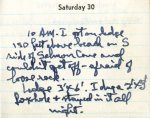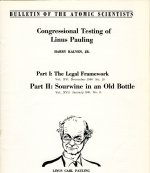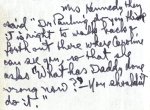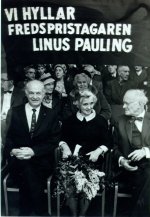
Increasing Involvement in World Peace, Part 2 (1959-1963)
1959
In April, Pauling formulates his hydrate microcrystal theory of anesthesia. He reasons that the structuring of water molecules around proteins in the brain might interfere with the electrical oscillations involved in consciousness.
Linus and Ava Helen Pauling visitDr. Albert Schweitzer’s hospital in Lambaréné in French Equatorial Africa from July 16 to July 24. Schweitzer and Pauling agree that nuclear war must be completely ruled out as a means of solving disputes between nations.
Linus and Ava Helen Pauling participate in the Fourth Pugwash Conference in Baden, Austria.
The Paulings spend the first week in August attending the Fifth World Conference against Atomic and Hydrogen Bombs in Hiroshima, Japan. Pauling is the guiding member of a drafting committee that writes the Hiroshima Appeal, the principal document issued by the conference. During the second week of August, Pauling lectures at Hiroshima University and other institutions, and his wife also gives some talks.
On October 25, Pauling speaks about fallout at Carnegie Hall in New York City. His speech is later reprinted as a pamphlet.
Pauling gives the Messenger Lectures at Cornell University in October.
1960
From Sunday, January 31, until Monday morning, February 1, Pauling is trapped on a ledge of a steep cliff near his ranch. His disappearance creates great concern, and his rescue makes news in many publications.
On June 21, Pauling testifies before the Subcommittee to Investigate the Administration of the Internal Security Act of the Committee on the Judiciary in Washington, D.C. He is asked to furnish the letters of the individuals who helped him gather the signatures for his United Nations petition, but he expresses concern about his duty to the people who worked for the petition. He feels that they may be subjected to the harassment that he has been subjected to. Despite his concerns, he is ordered by the subcommittee to make another appearance in the near future.
On October 11, Pauling again appears before the subcommittee and refuses to reveal the names of those who helped circulate his petition. He is excused without any orders to produce the names of his helpers or other documents.
In the November elections, Pauling votes for John F. Kennedy, the Democratic candidate, who is running against Richard M. Nixon, the Republican.
1961
On January 2, Time magazine chooses the scientists of the United States as its "Men of the Year." Linus Pauling is one of the scientists on the cover.
On March 17, Pauling is honored as Humanist of the Year by the American Humanist Association. Mrs. Cyrus Eaton presents the award to him at a meeting in Cleveland, Ohio, where Pauling speaks on "Humanism and Peace."
Pauling publishes his molecular theory of general anesthesia in Science. He feels that the time is ripe for the formation of a "molecular psychology," in which chemical techniques and theories can illuminate such phenomena as consciousness, memory, and sedation.
On January 16, Linus and Ava Helen Pauling issue "An Appeal to Stop the Spread of Nuclear Weapons." Because France has carried out a nuclear test, the Paulings feel that it is necessary that vigorous steps be taken to halt the spread of nuclear weapons.
In May, Linus and Ava Helen Pauling attend an international peace conference in Oslo, Norway. This conference of physical, biological, and social scientists from fifteen countries issues the "Oslo Statement," which urges the cessation of nuclear tests and the initiation of complete global disarmament.
On August 6, Pauling gives a "Hiroshima Day Address" before the Los Angeles Committee for a Sane Nuclear Policy.
On October 18, after the Soviet Union resumes nuclear testing, Pauling sends a telegram to Prime Minister Nikita Khrushchev, entreating him to carry out no further tests (at the same time, he sends a telegram to President Kennedy, asking that the United States undertake no atmospheric nuclear tests). Pauling receives a long letter from Khrushchev, which is dated October 27, stating that the Soviet Union feels regrettably forced to carry out new tests with nuclear weapons.
In November, Linus and Ava Helen Pauling attend the second centenary celebrations of the Academy of Science in Moscow. While there, they lecture on disarmament and peace.
1962
On April 24, President Kennedy orders the resumption of atmospheric nuclear testing. On April 25, the United States detonates a nuclear device at the Christmas Island proving ground.
On April 28 and 29, Linus and Ava Helen Pauling, with several hundred other demonstrators, march before the White House with signs saying that "We Have No Right to Test" and other slogans. On the evening of April 29, Linus and Ava Helen Pauling enter the White House as guests of President John F. Kennedy and Mrs. Kennedy, who have invited many American Nobel Prize winners to a dinner party.
Pauling receives his high-school diploma from Washington High School in Portland, Oregon.
Pauling and Emile Zuckerkandl publish an important article, "Molecular Disease, Evolution, and Genic Heterogeneity" in an Albert Szent-Györgyi dedicatory volume, Horizons in Biochemistry.
On August 23, Michael Levi Matar, a lawyer representing Pauling, writes to the magazine National Review, announcing that it is Pauling’s intention to sue because of the "vicious libel" published about him in the magazine’s editorial, "The Collaborators."
In September, Pauling attend the Tenth Pugwash Conference, "Scientists and World Affairs," in London.
In October, Pauling, while at Ohio State University in Columbus, protests President Kennedy’s handling of the Cuban Missile Crisis. He wires a note to the president, objecting to the naval blockade, calling it "an act of the utmost irresponsibility." Ava Helen Pauling travels to Washington, where she takes part in a demonstration that she has helped arrange, in front of the White House. Meanwhile, university officials cancel Pauling’s press conference, which deeply angers him.
On November 1, Pauling receives the Gandhi Peace Prize (the other winner is James P. Warburg, the economist and author).
In the November elections, Pauling receives 2,694 write-in votes for United States Senator from California.
1963
On January 17, Pauling files a lawsuit against the National Review, asking damages of $500,000 for the first editorial, and damages of $500,000 for a second editorial. He complains that the National Review recklessly and maliciously intended to destroy his good reputation.
On October 10, the day that a partial nuclear test ban treaty goes into effect, the Nobel Peace Prize Committee of the Norwegian Parliament announces the award of the 1962Nobel Peace Prize to Linus Pauling.
On October 25, an editorial entitled "A Weird Insult from Norway" appears in Life magazine. It deplores Pauling’s stands on the Cuban Missile Crisis, the Korean War, and nuclear testing. This negative reaction to Pauling’s Nobel Peace Prize is also typical of many members of the CIT community. Consequently, the Division of Chemistry and Chemical Engineering does nothing to honor or recognize Pauling’s award. President DuBridge states that he prefers to work for peace in a way other than what the Norwegian Committee deems proper. According to Ava Helen, these reactions hurt her husband deeply and constitute the principal reason for his leaving CIT.
At the end of October, Pauling announces that he has accepted the appointment, effective November 1, as a member of the staff of the Center for the Study of Democratic Institutions in Santa Barbara, California. He hopes to continue, in this new environment, his work in science, medicine, and world affairs. He will be on a leave of absence from CIT for the rest of the academic year, though he will continue to supervise his experimental and theoretical research in the fields of chemistry in relation to mental disease and the mechanism of action of anesthetic agents.
On December 10, he receives the Nobel Peace Prize for 1962 in Norway. When the popular press, even Chemical and Engineering News, play down Pauling’s Peace Prize, he is very disappointed. The treatment in Chemical and Engineering News especially rankles him, for he feels, with justification, that a former president of the American Chemical Society who becomes the first person to win two unshared Nobel Prizes merits extensive treatment. Therefore, he resigns from the American Chemical Society because of his dissatisfaction with the attitude of the society toward him, his bomb-test suits, and his Nobel Peace Prize.
Table of Contents
- The Ancestry of Linus Pauling (The Paulings)
- The Ancestry of Linus Pauling (The Darlings)
- Linus Pauling's Childhood (1901-1910)
- Linus Pauling's Adolescence (1910-1917)
- Pauling's Years as an Undergraduate at Oregon Agricultural College, Part 1 (1917-1919)
- Pauling's Years as an Undergraduate at Oregon Agricultural College, Part 2 (1919-1922)
- Linus Pauling as a Graduate and Postdoctoral Student at the California Institute of Technology, Part 1 (1922-1923)
- Linus Pauling as a Graduate and Postdoctoral Student at the California Institute of Technology, Part 2 (1924-1926)
- A Guggenheim Fellow in Europe during the Golden Years of Physics (1926-1927)
- Early Career at the California Institute of Technology (1927-1930)
- Pauling's Great Years of Achievement in Structural Chemistry, Part 1 (1931-1932)
- Pauling's Great Years of Achievement in Structural Chemistry, Part 2 (1933-1935)
- Pauling's Increasing Involvement in Molecular Biology (1936-1939)
- The War Years, Part 1 (1940-1942)
- The War Years, Part 2 (1943-1945)
- The Postwar Years, Part 1 (1946-1947)
- The Postwar Years, Part 2 (1948-1949)
- Proteins, Passports, and the Prize (1950-1954)
- Increasing Involvement in World Peace, Part 1 (1955-1958)
- Increasing Involvement in World Peace, Part 2 (1959-1963)
- The Center for the Study of Democratic Institutions (1964-1967)
- The University of California, San Diego (1968-1969)
- Stanford University (1969-1972)
- An Institute for Science and Orthomolecular Medicine, Part 1 (1973-1977)
- An Institute for Science and Orthomolecular Medicine, Part 2 (1978-1981)
- The Years Alone: Pauling after the Death of Ava Helen, Part 1 (1982-1988)
- The Years Alone: Pauling after the Death of Ava Helen, Part 2 (1989-1994)
- About the Author





